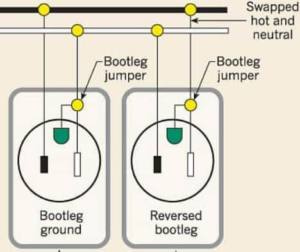Everyone,
This is in response to my RVelectricity article on Reverse Polarity Bootleg Grounds last month. What a great question.
Dear Mike,
Thanks, Mike, for an easy to read and understand article on RPBG conditions. Please excuse my ignorance if this is a stupid question. Does an RPBG (Reverse Polarity Bootleg Ground) problem only occur on 3-prong 15/20-amp outlets or can it also happen on 30-amp or 50-amp outlets? —Paul
You can read the original post HERE!
Dear Paul,
In a nutshell, a Reverse Polarity Bootleg Ground condition happens when a DIY handyman or sleazy electrician upgrades an old 2-prong ungrounded outlet to a 3-prong grounded outlet. If there’s no ground wire already run to the box they’ll sometimes just jumper between the green ground screw and the white neutral wire on the back of the outlet. That’s called a “Bootleg Ground” which is a code violation but not immediately dangerous.
However, if the black (hot) and white (neutral) wire are also accidentally reversed somewhere in the circuit (which is surprisingly easy to do in old wiring), that creates what I call a Reverse Polarity Bootleg Ground, or RPBG for short. This is dangerous in the extreme since whatever you plug into an RPBG outlet will operate normally, but the skin and chassis of it will be energized with a full 120-volts AC at circuit breaker current (20 or 30 amps). So while there are no warning signs that your RV’s skin, chassis, hitch and tow vehicle have a voltage on them, if anyone touches anything metal on the energized RV while standing on the ground it’s like grabbing onto a live wire. And yes, that can easily kill you or a loved one.
I’ve only ever seen an RPBG condition on one 30-amp pedestal that was hung on the side of a garage, so it’s certainly possible. While it should be nearly impossible to make a mistake and miswire a 50-amp outlet with an RPBG, I’ve learned to never say never when it comes to wiring mistakes. If you have a unexplained hot-skin voltage even though the home or pedestal outlet tests OK, suspect an RPBG problem.
If you haven’t read this before, here’s an article with a quick video of me demonstrating how to safely test your RV for a hot-skin voltage using an inexpensive Non-Contact Voltage Tester. Read more about it HERE.
OK, everyone. Remember that electricity is a useful and powerful force, so we all need to pay attention to safety precautions while using it.
Let’s play safe out there…. Mike








"While it should be nearly impossible to make a mistake and miswire a 50-amp outlet with an RPBG,"
Somebody is going to take that as a challenge!